Fret positions found graphically
using a refined “18 rule”
With all the free fret scale calculator floating around the internet, it might seem silly to bother learning a manual method.
But what if you were shipwrecked on a deserted island and wanted to build an instrument?
Then you’d wish you took a minute to glimpse this page… or maybe that you had stayed awake in geometry…;-)
Don’t worry this actually requires almost no math, just the ability to use a ruler, compass and a square.
To make the math really easy start with a 27” string length.
That will be the long leg, or base of a pointy isosceles triangle we'll draw. It will look like a long wedge or ramp.
The short leg comes from the “18” part of our rule, found by dividing 18 into the string length of 27 producing 1.5”
That's all the math we'll need to do for this system. 27/18= 1.5
More
mathamatical methods like the 12th root of 2
tells us a more accurate figure would be 17.817 instead of 18. If you use that
figure, 17.817, instead of 18 you get this length for our vertical leg..
If you use that
figure, 17.817, instead of 18 you get this length for our vertical leg..
1.5154066341134871190436100353595 of an inch.
Now we see why folks might round it off to 18, but we can do a little better than that.
If you take a
close look you’ll see it is .0154 thousandths larger than our 18 rule.
1/64 th of an inch = 0.015625< o:p > < /O:P >
So add a 1/64
of an inch to our vertical leg and you have it pretty darn close.
Connect the
ends to close the triangle. Let's call that top line the "ramp line."
Now get out
your compass with the sharpest point you have, and scribe an arc from the top of
the short leg to intersect the long leg.
That’s our
first fret position.
Draw a right
angle line from that point
up to intersect our "ramp line." Strike an arc from there to the long leg
and you get fret 2… and so on.
That will give you as many frets as you want to draw.

For clarity,
I’ll just show twelve frets.
You can check
how well you did by measuring from your nut point to your 12th fret and see how close it is to 13.5”.
Now this would be fine if you’re making an instrument with a 27” string length, but what if we want a 25" string length pattern?
Here’s what you do. Draw lines from all your critical points, nut, frets and bridge, to an arbitrary point some distance away from your 12th fret. For clarity I’m using 13” [it stays within my screen capture] but you could make it farther away.

There now you have a handy dandy "Fret Fan."
Here's a TIP:
You could skip all the geometry above, and borrow a known accurate fret scale, say from a decent guitar, and make a "Fret Fan" from that.
With this method you can make an instrument “by the seat of your pants” without even knowing what the string length is, make a paper template from nut to bridge…
Lay that template
or any desired string length on this “fan” and if you keep it parallel to
the original line you can transfer the fret points to your template. If you want
to do a longer string length, for a bass perhaps, just continue your fan lines
out thru your points.
As you can see,
the accuracy of this system depends on your drawing tools and your skills. Any
errors that get made become cumulative. Add to this the problem of having had to
make your compass and square and paper and pencil from sea shells and palm
leaves on your island, and you may wish you’d brought your laptop and inkjet
printer…;-)
Better yet go
download Wfret here:
It not only
calculates fret placement in inch or metric it lets you print out a paper
template.
Have fun!
David Beede